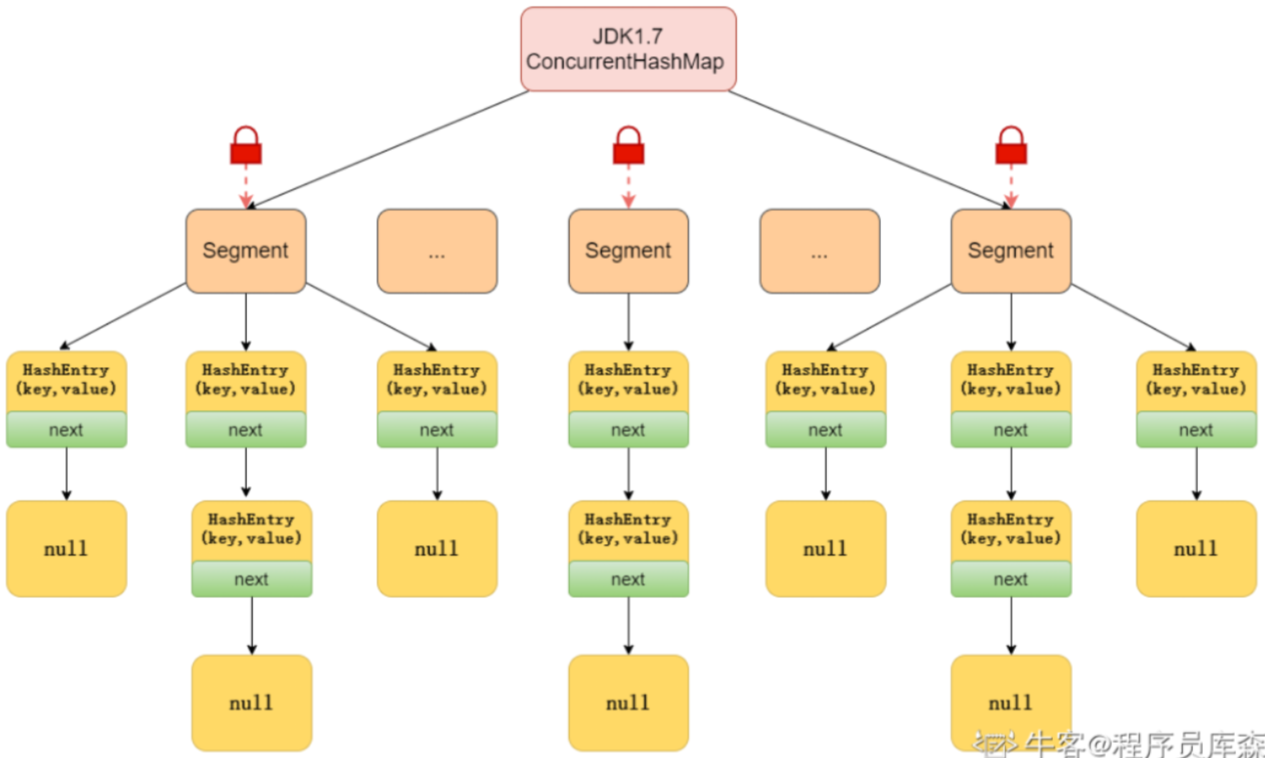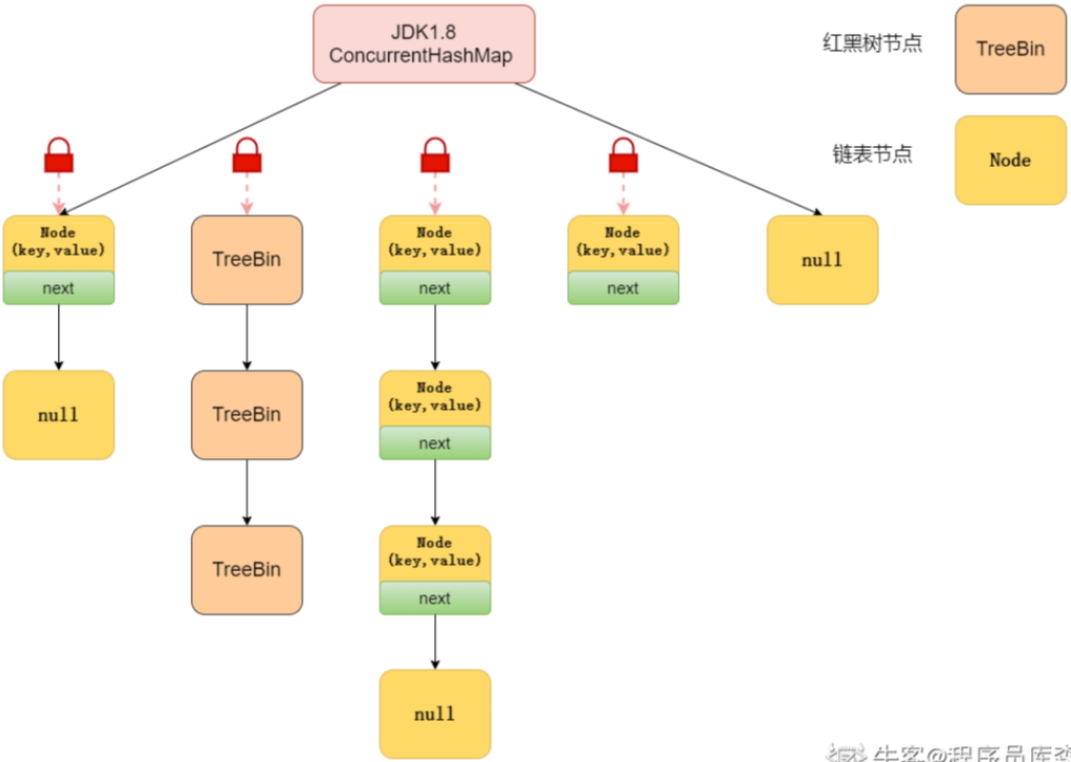前言
之前我们剖析了 HashMap 底层原理,需要的小伙伴可点击传送门跳转。
概述
通过学习,我们已经知道了 HashMap 是非线程安全的,为了解决线程安全问题,有哪些解决方案呢?
- HashTable
- Collections.synchronizedMap
以上两种方法都可以解决HashMap的线程安全问题,但这二者有个共同点,会使用 synchronized 将 hashmap 锁住来实现避免多个线程同时写入HashMap 带来的线程安全问题。导致一个线程获得资源的同时,其他线程无论读还是写操作,都会被阻塞。可想而知,这会导致性能效率低下。
那问题来了,有没有能同时兼顾线程安全和运行效率的解决方案?
本文主角登场:ConcurrentHashMap,我们来看看它是如何提高多线程操作效率的。
jdk1.7
jdk1.7 中 ConcurrentHashMap 是由 Segment 数组 和 HashEntry数组组成,每个 Segment 元素中又存放着 数组+链表的数据结构。
ConcurrentHashMap 将数据分段存储,给每段数据(Segment)配锁,当一个线程访问其中一个 Segment 时,其他Segment数据也能被其他线程访问,实现了并发访问。

【图片来自网络】
从图得知,ConcurrentHashMap 定位元素分为两个步骤:
- 定位到 Segment
- 定位到元素所在的链表
我们来看看ConcurrentHashMap 的内部类Segment 究竟是什么?

Segment 是 ReentrantLock 的子类,所以 Segment 是一种可重入锁,用来锁住 HashEntry 数组。Segment 数组默认大小为16,也就是并发度是16
存放元素的 HashEntry 也是一个静态内部类,组成如下:

其中,value 和 下一个节点 next 用 volatile 修饰,保证了多线程环境下数据获取时的可见性。
jdk1.8
和 jdk1.8 的 HashMap 的实现一样,采用了 Node数组+链表+红黑树的实现方式,抛弃了 jdk1.7中的 Segment 分段锁机制,采用 Synchronized 和 CAS 实现更加细粒度的锁。
将锁的级别控制在了更细粒度的哈希桶数组元素级别,只要锁住这个桶的头结点,就不会影响其他哈希桶数组元素的读写,相对于 1.7 大大提高了并发度。

源码分析
常量值
private static final int MAXIMUM_CAPACITY = 1 << 30; // 最大容量
private static final int DEFAULT_CAPACITY = 16; // 默认容量
static final int MAX_ARRAY_SIZE = Integer.MAX_VALUE - 8; // 最大数组长度
private static final int DEFAULT_CONCURRENCY_LEVEL = 16; // 默认并行级别
private static final float LOAD_FACTOR = 0.75f; // 负载系数
static final int TREEIFY_THRESHOLD = 8; // 树化阈值
static final int UNTREEIFY_THRESHOLD = 6; // 取消树化阈值
static final int MIN_TREEIFY_CAPACITY = 64; // 最小树化数组容量,转换为红黑树的最小数组长度
private static final int MIN_TRANSFER_STRIDE = 16;
private static int RESIZE_STAMP_BITS = 16;
private static final int MAX_RESIZERS = (1 << (32 - RESIZE_STAMP_BITS)) - 1; // 扩容的最大的线程的数量
private static final int RESIZE_STAMP_SHIFT = 32 - RESIZE_STAMP_BITS;
static final int MOVED = -1; // hash for forwarding nodes
static final int TREEBIN = -2; // hash for roots of trees
static final int RESERVED = -3; // hash for transient reservations
static final int HASH_BITS = 0x7fffffff; // usable bits of normal node hash // hash 位数,int 最大值
static final int NCPU = Runtime.getRuntime().availableProcessors(); // 获取CPU核数
private static final ObjectStreamField[] serialPersistentFields = { // 序列化兼容性
new ObjectStreamField("segments", Segment[].class),
new ObjectStreamField("segmentMask", Integer.TYPE),
new ObjectStreamField("segmentShift", Integer.TYPE)
};
initTable()
private final Node<K,V>[] initTable() {
Node<K,V>[] tab; int sc;
while ((tab = table) == null || tab.length == 0) {
//如果一个线程发现sizeCtl<0,意味着另外的线程执行CAS操作成功,当前线程只需要让出cpu时间片
if ((sc = sizeCtl) < 0)
// 使当前线程由执行状态变为就绪状态,让出cpu
Thread.yield(); // lost initialization race; just spin
// compareAndSwapInt参数(要修改的值的对象,要修改的数据的值在内存中的偏移量(找到要修改的值),期望内存中的值,要修改内存的值)
else if (U.compareAndSwapInt(this, SIZECTL, sc, -1)) {
try {
if ((tab = table) == null || tab.length == 0) {
int n = (sc > 0) ? sc : DEFAULT_CAPACITY;
@SuppressWarnings("unchecked")
Node<K,V>[] nt = (Node<K,V>[])new Node<?,?>[n];
table = tab = nt;
sc = n - (n >>> 2); //0.75*capacity
}
} finally {
sizeCtl = sc;
}
break;
}
}
return tab;
}
putVal()
final V putVal(K key, V value, boolean onlyIfAbsent) {
if (key == null || value == null) throw new NullPointerException();
// 将 key的hash值再 hash,双重 hash,降低冲突概率
int hash = spread(key.hashCode());
int binCount = 0;
for (Node<K,V>[] tab = table;;) {
Node<K,V> f; int n, i, fh;
// 判断是否为空
if (tab == null || (n = tab.length) == 0)
// 初始化table
tab = initTable();
// 当前 bucket 为空,使用 cas 机制将put的值放到此bucket,put操作完成
else if ((f = tabAt(tab, i = (n - 1) & hash)) == null) {
if (casTabAt(tab, i, null,
new Node<K,V>(hash, key, value, null)))
break; // no lock when adding to empty bin
}
// 如果bucket不为空,并且hash = -1,说明当前map正在扩容,其他线程先协助扩容,加快速度(多线程扩容)
else if ((fh = f.hash) == MOVED)
tab = helpTransfer(tab, f);
// 如果 hash 冲突了,且 hash 值不为 -1
else {
V oldVal = null;
// 同步 f 节点,防止增加链表的时候导致链表成环状
synchronized (f) {
// 如果对应的下标位置的节点没有改变
if (tabAt(tab, i) == f) {
// 如果 f 节点的hash >= 0
if (fh >= 0) {
// 链表初始长度
binCount = 1;
// 死循环,直至将节点添加到链表尾部,binCount用来计算链表长度
for (Node<K,V> e = f;; ++binCount) {
K ek;
// 如果 e 的 key 与要插入的节点key值相同 或者 e 的hash 与 要插入的节点的 hash 相同
if (e.hash == hash &&
((ek = e.key) == key ||
(ek != null && key.equals(ek)))) {
oldVal = e.val;
if (!onlyIfAbsent)
// 完成节点赋值,put操作成功
e.val = value;
break;
}
Node<K,V> pred = e;
// 判断 e 是否有后继节点,如否,将后继节点赋给 e,循环
if ((e = e.next) == null) {
pred.next = new Node<K,V>(hash, key,
value, null);
break;
}
}
}
// 如果 f 节点的 hash < 0 并且 f 是树
else if (f instanceof TreeBin) {
Node<K,V> p;
binCount = 2;
// 向树中添加节点
if ((p = ((TreeBin<K,V>)f).putTreeVal(hash, key,
value)) != null) {
oldVal = p.val;
if (!onlyIfAbsent)
p.val = value;
}
}
}
}
// 链表长度 >= 8 时,将链表转换为红黑树
if (binCount != 0) {
if (binCount >= TREEIFY_THRESHOLD)
treeifyBin(tab, i);
if (oldVal != null)
return oldVal;
break;
}
}
}
// 更新容器容量,并判断是否需要扩容
addCount(1L, binCount);
return null;
}
helpTransfer()
final Node<K,V>[] helpTransfer(Node<K,V>[] tab, Node<K,V> f) {
Node<K,V>[] nextTab; int sc;
// 数据校验,如果 tab不为null 并且node节点是转移类型 并且 node 节点的 nextTable 不为null,符合以上条件尝试协助扩容操作
if (tab != null && (f instanceof ForwardingNode) &&=--
(nextTab = ((ForwardingNode<K,V>)f).nextTable) != null) {
// 根据length得到一个标识符号
int rs = resizeStamp(tab.length);
// 如果 nextTab 和 tab 都没有被并发修改 并且 sizeCtl < 0(说明还在扩容)
while (nextTab == nextTable && table == tab &&
(sc = sizeCtl) < 0) {
// sc 右移16位 != 标识 (sc 前16位不等于标识符,代表标识符变化了)
// sc == rs + 1 (代表扩容结束了,默认第一个协助扩容的线程设置 sc = rs左移16位+2,当第一个线程结束扩容了,会将 sc -1,所以 sc = rs+1代表扩容结束了)
// sc == rs + MAX_RESIZERS (sc = rs+65535,如果达到了最大协助线程的数量)
// transferIndex <= 0 (转移下标正在调整,代表扩容结束)
// 满足以上任一条件,结束协助扩容
if ((sc >>> RESIZE_STAMP_SHIFT) != rs || sc == rs + 1 ||
sc == rs + MAX_RESIZERS || transferIndex <= 0)
break;
// 如果以上都不是,将 sizeCTL + 1 ,标识增加了一个线程协助扩容
if (U.compareAndSwapInt(this, SIZECTL, sc, sc + 1)) {
// 将节点转移到新table
transfer(tab, nextTab);
break;
}
}
return nextTab;
}
return table;
}
addCount()
// 更新容器容量方法
private final void addCount(long x, int check) {
CounterCell[] as; long b, s;
// 如果counterCells不为null 或者 更新容器容量不成功时
if ((as = counterCells) != null ||
!U.compareAndSwapLong(this, BASECOUNT, b = baseCount, s = b + x)) {
CounterCell a; long v; int m;
boolean uncontended = true;
if (as == null || (m = as.length - 1) < 0 ||
(a = as[ThreadLocalRandom.getProbe() & m]) == null ||
!(uncontended =
U.compareAndSwapLong(a, CELLVALUE, v = a.value, v + x))) {
// 多线程 cas 失败时执行, 会向 CounterCell中存储因为高并发导致cas更新baseCounter失败时的值
fullAddCount(x, uncontended);
return;
}
if (check <= 1)
return;
// 计算容器容量
s = sumCount();
}
if (check >= 0) {
Node<K,V>[] tab, nt; int n, sc;
// 当条件满足开始扩容
while (s >= (long)(sc = sizeCtl) && (tab = table) != null &&
(n = tab.length) < MAXIMUM_CAPACITY) {
int rs = resizeStamp(n);
// 说明此时已经有线程正在扩容
if (sc < 0) {
if ((sc >>> RESIZE_STAMP_SHIFT) != rs || sc == rs + 1 ||
sc == rs + MAX_RESIZERS || (nt = nextTable) == null ||
transferIndex <= 0)
// 有线程在扩容时,直接break
break;
// 此时其他线程如果扩容完毕,修改 sc 的值,继续扩容
if (U.compareAndSwapInt(this, SIZECTL, sc, sc + 1))
transfer(tab, nt);
}
else if (U.compareAndSwapInt(this, SIZECTL, sc,
(rs << RESIZE_STAMP_SHIFT) + 2))
transfer(tab, null);
// 计算容器容量
s = sumCount();
}
}
}
get()
public V get(Object key) {
Node<K,V>[] tab; Node<K,V> e, p; int n, eh; K ek;
// 双重 hash
int h = spread(key.hashCode());
// 如果 table 不为空 并且查找的 key 的节点不为 null
if ((tab = table) != null && (n = tab.length) > 0 &&
(e = tabAt(tab, (n - 1) & h)) != null) {
// 如果节点 e 的hash 是要查找的key的hash
if ((eh = e.hash) == h) {
// 如果节点 e 的 key 与要查找的key相等
if ((ek = e.key) == key || (ek != null && key.equals(ek)))
// 返回 value
return e.val;
}
// 判断是否是红黑树
else if (eh < 0)
// 遍历红黑树查找元素
return (p = e.find(h, key)) != null ? p.val : null;
// 遍历链表查找key值所在的节点e
while ((e = e.next) != null) {
if (e.hash == h &&
((ek = e.key) == key || (ek != null && key.equals(ek))))
return e.val;
}
}
return null;
}
size()
public int size() {
long n = sumCount();
return ((n < 0L) ? 0 :
(n > (long)Integer.MAX_VALUE) ? Integer.MAX_VALUE :
(int)n);
}
// baseCount 指的是容器容量
private transient volatile long baseCount;
final long sumCount() {
// CounterCell 就是用来记录容器容量的内部类
CounterCell[] as = counterCells; CounterCell a;
long sum = baseCount;
if (as != null) {
// 累加容器数量,因为CounterCell记录的是因为高并发导致更新baseCount失败时的值,所以,需要遍历CounterCell进行累加
for (int i = 0; i < as.length; ++i) {
if ((a = as[i]) != null)
sum += a.value;
}
}
return sum;
}
mappingCount()
// jdk1.8 推荐使用 mappingCount() 代替 size()
// 此方法返回的值是个估计值,如果存在并发插入/删除,实际计数可能不是很准确
public long mappingCount() {
long n = sumCount();
return (n < 0L) ? 0L : n; // ignore transient negative values
}






















 5418
5418

 被折叠的 条评论
为什么被折叠?
被折叠的 条评论
为什么被折叠?








